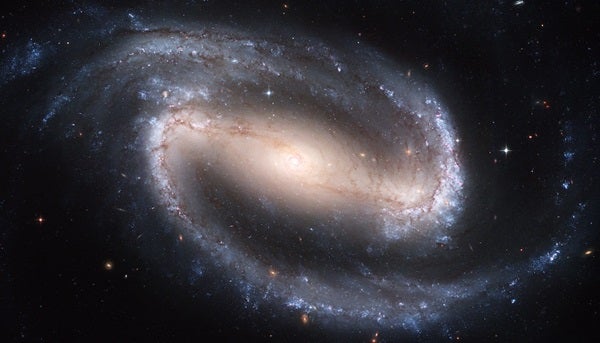Do barred galaxies have two or more supermassive black holes in the central region? Can a single black hole in the center create a bar?
Barred spiral galaxies are fairly common throughout the universe — at least one-third to one-half of spiral galaxies show some kind of central bar structure, including our own Milky Way. Because bars form in the centers of galaxies, which is also where supermassive black holes reside, it’s easy to think the two are connected. However, the gravitational influence of a galaxy’s supermassive black hole is so limited that it has nothing to do with how or why a central bar forms.
But, you may be saying, supermassive black holes contain millions or billions of Suns’ worth of mass. How can such a massive object not be related to the central bar? There are two main reasons: First, the influence of an object’s gravity is inversely proportional to the square of the distance you are from that object. This is a complicated way of saying that the gravitational pull you feel from something very quickly becomes weaker as you move away from it. So, given that the bulge of, say, the Milky Way stretches nearly 7,000 light-years across, the sphere of influence around its supermassive black hole is not nearly large enough to dictate the motions of material throughout the entire bulge. The second reason is that the mass of a galaxy’s bulge itself — the stars and gas — far outweighs that of its supermassive black hole. The difference is quite extreme: The average supermassive black hole accounts for only about 0.5 percent of the total mass in a galaxy’s bulge.
So, despite its location, a supermassive black hole has nothing to do with the formation of a bar structure. Even the acquisition of an additional supermassive black hole from a colliding galaxy could not create a bar — such an event might, in fact, disrupt one. Galactic bars are instead caused by gravitational instabilities in the motion of material in a galaxy’s bulge. Because the material throughout a galaxy is not distributed evenly, instabilities arise in areas that start out slightly denser than their surroundings, causing them to attract more material. Given time, the orbits of numerous stars and gas clouds will overlap, creating the structure we see. This is similar to the way spiral arms are generated as density waves cause material in a galaxy’s disk to pile up in certain orbits like a traffic jam as the galaxy rotates. And although a bar or spiral arms may look solid, they are really just dense regions where more material is present. Their shape, size, and even existence can change within a single galaxy over its lifetime.










